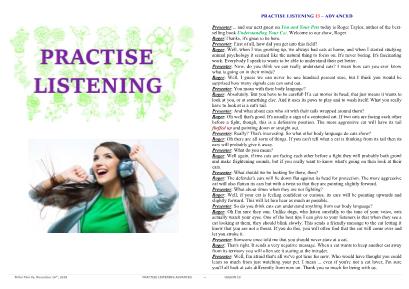Bài thực hành nghe Tiếng Anh nâng cao - Bài 13 - Thẩm Tâm Vy - Năm 2018 (Có âm thanh)
Bạn đang xem tài liệu "Bài thực hành nghe Tiếng Anh nâng cao - Bài 13 - Thẩm Tâm Vy - Năm 2018 (Có âm thanh)", để tải tài liệu gốc về máy bạn click vào nút DOWNLOAD ở trên

Thẩm Tâm Vy, November 16th, 2018 PRACTISE LISTENING ADVANCED – LESSON 13 PRACTISE LISTENING 13 – ADVANCED Presenter:... and our next guest on You and Your Pets today is Roger Taylor, author of the best- selling book Understanding Your Cat. Welcome to our show, Roger. Roger:Thanks, it's great to be here. Presenter: First of all, how did you get into this field? Roger: Well, when I was growing up, we always had cats at home, and when I started studying animal psychology it seemed like the natural thing to focus on. It's never boring. It's fascinating work. Everybody I speak to wants to be able to understand their pet better. Presenter: Now, do you think we can really understand cats? I mean how can you ever know what is going on in their minds? Roger: Well, I guess we can never be one hundred percent sure, but I think you would be surprised how many signals cats can send out. Presenter: You mean with their body language? Roger: Absolutely. But you have to be careful! If a cat moves its head, that just means it wants to look at you, or at something else. And it uses its paws to play and to wash itself. What you really have to look at is a cat's tail. Presenter: And what about cats who sit with their tails wrapped around them? Roger: Oh well that's good. It's usually a sign of a contented cat. If two cats are facing each other before a fight, though, this is a defensive position. The more aggressive cat will have its tail fluffed up and pointing down or straight out. Presenter: Really? That's interesting. So what other body language do cats show? Roger: Oh there are all sorts of things. If you can't tell what a cat is thinking from its tail then its ears will probably give it away. Presenter: What do you mean? Roger: Well again, if two cats are facing each other before a fight they will probably both growl and make frightening sounds, but if you really want to know what's going on then look at their ears. Presenter: What should we be looking for there, then? Roger: The defender's ears will lie down flat against its head for protection. The more aggressive cat will also flatten its ears but with a twist so that they are pointing slightly forward. Presenter: What about times when they are not fighting? Roger: Well, if your cat is feeling confident or curious, its ears will be pointing upwards and slightly forward. This will let him hear as much as possible. Presenter: So do you think cats can understand anything from our body language? Roger: Oh I'm sure they can. Unlike dogs, who listen carefully to the tone of your voice, cats actually watch your eyes. One of the best tips I can give to your listeners is that when they see a cat looking at them, they should blink slowly. This sends a friendly message to the cat letting it know that you are not a threat. If you do this, you will often find that the cat will come over and let you stroke it. Presenter: Someone once told me that you should never stare at a cat. Roger: That's right. It sends a very negative message. When a cat wants to keep another cat away from its territory you will often see it staring at the intruder. Presenter: Well, I'm afraid that's all we've got time for now. Who would have thought you could learn so much from just watching your pet. I mean ... even if you're not a cat lover, I'm sure you'll all look at cats differently from now on. Thank you so much for being with us.
Tài liệu đính kèm:
 bai_thuc_hanh_nghe_tieng_anh_nang_cao_bai_13_tham_tam_vy_nam.pdf
bai_thuc_hanh_nghe_tieng_anh_nang_cao_bai_13_tham_tam_vy_nam.pdf 01. LISTENING 13 (Slow).mp3
01. LISTENING 13 (Slow).mp3 02. LISTENING 13 (Normal).mp3
02. LISTENING 13 (Normal).mp3





